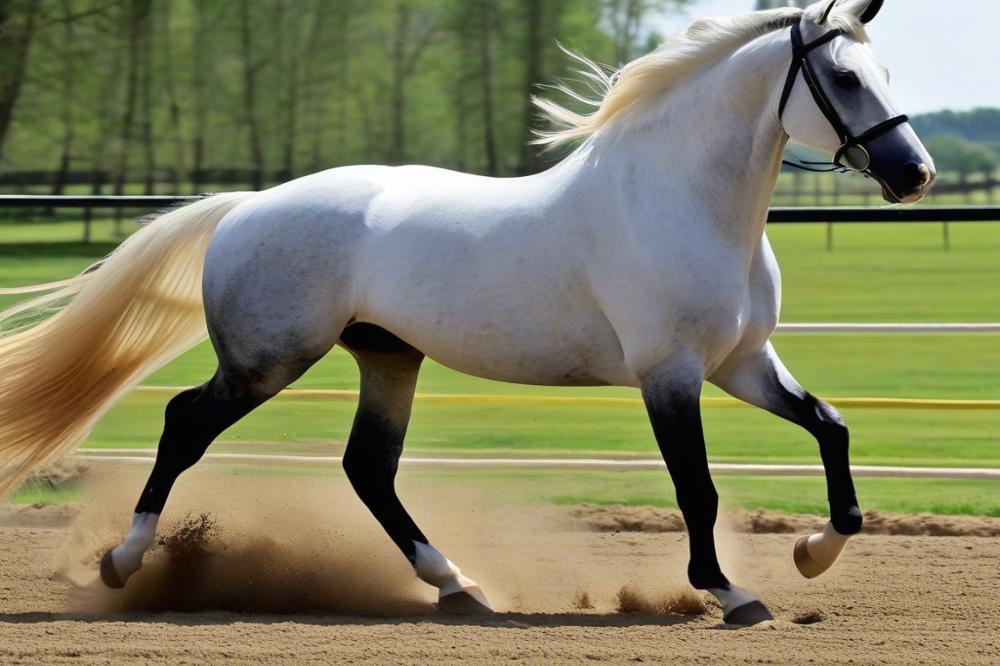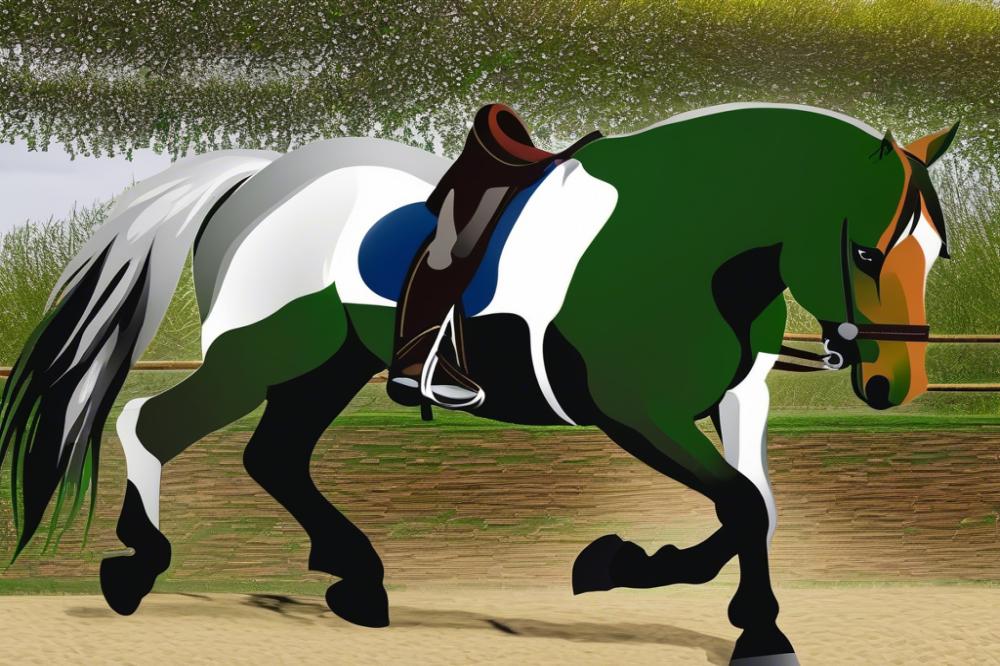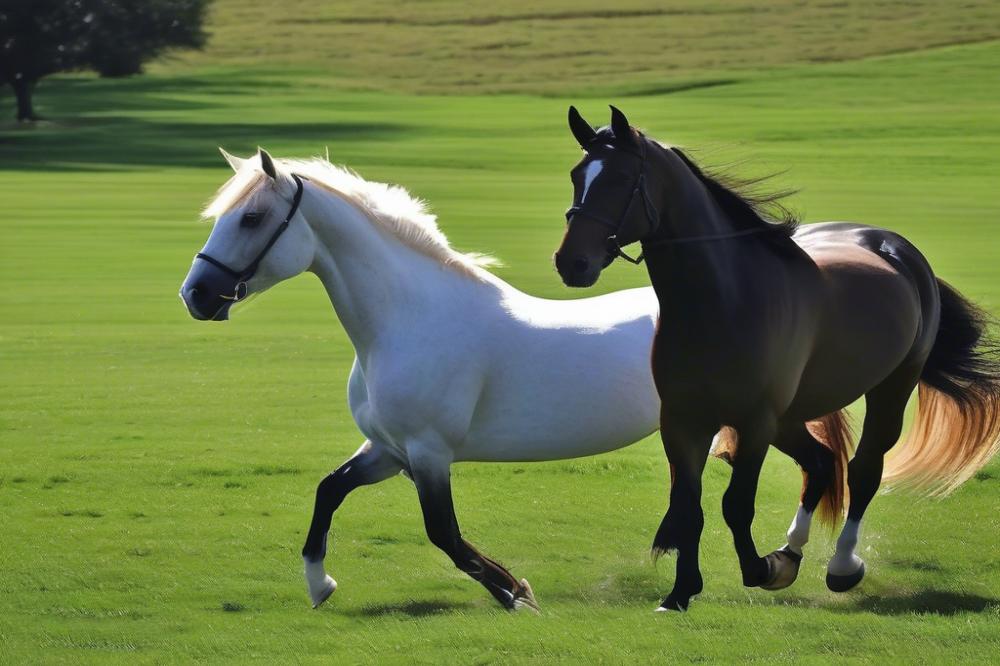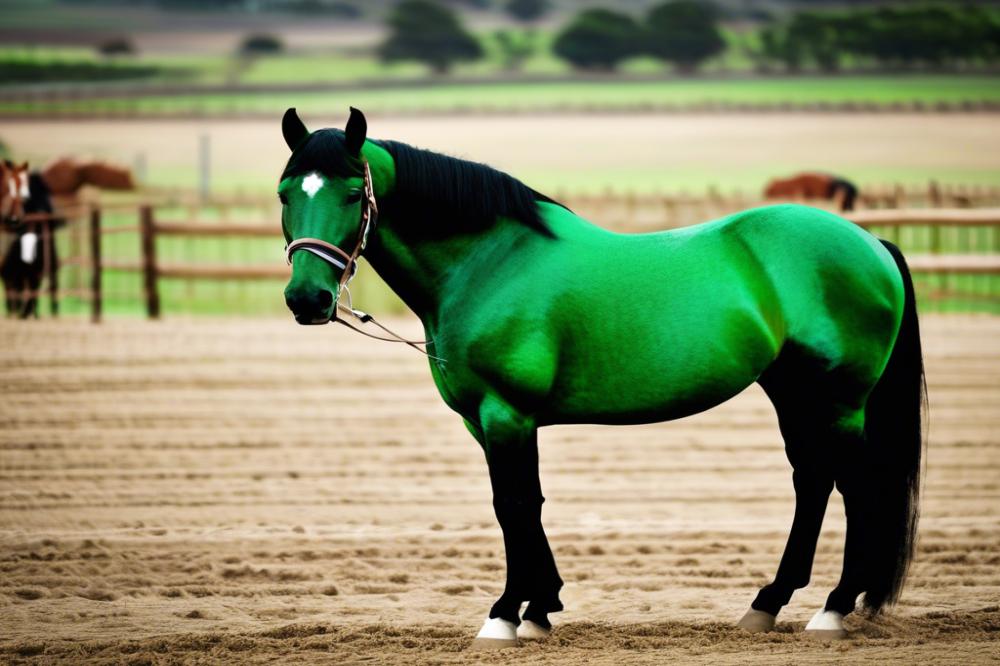Defining a Green Broke Horse
Let’s start with the basics, shall we? When we talk about a green broke horse, we mean a young equine that has had minimal training. These horses often have a bit of saddle time but haven’t yet gained the full range of skills they’ll need for riding and working confidently. Picture a newly opened book; the pages are there, but the story hasn’t quite started yet.
The Importance of Proper Training

You might wonder why thorough horse training matters. Well, think of it like teaching a toddler to walk. It’s a big deal, and if you don’t guide them effectively, they might stumble or fall. Similarly, a green broke horse requires careful instruction to build good habits and ensure a safe experience for both the rider and the horse. Proper training teaches the horse how to respond to cues, understand basic commands, and develop trust in their handler. Without a solid foundation, you could have a real rodeo on your hands, and let’s be honest, nobody wants to be the star of that show!
Setting Training Goals

Goals are essential when you start green broke training. Like setting your sights on the highest bar at the gym, you want to challenge your horse while keeping their spirit intact. Your main objectives should include improving horse behavior, enhancing communication, and developing confidence. As you work through these goals, remember to be patient; Rome wasn’t built in a day, and neither are well-trained horses! Tailoring your approach to the horse’s unique needs is key. Whether it’s focusing on specific equestrian techniques or making strides in horse care, stay flexible and responsive to their progress.
Have you ever seen an Akhal Teke horse? Those beautiful creatures sport such stunning coat colors that they can almost take your breath away. Each horse is different, much like every person you meet. So as you embark on this journey, don’t be surprised if you run into hiccups along the way—after all, it’s all part of the learning process. Just like the old saying goes, “You can’t make a silk purse out of a sow’s ear.” That is, unless you give it the right guidance. So, let’s saddle up and get ready for a rewarding experience that’ll have both you and your horse trotting towards success!
And hey, while we’re at it—can a cow and horse breed? You might be curious, but thankfully, we’re not here for that diversion! Let’s stay focused on training a green broke horse, and the delightful adventure it brings.
Understanding the Green Broke Horse

Characteristics of a Green Broke Horse
A green broke horse is like a teenager just starting to drive. They have some experience, but they still need a lot of guidance. Most likely, they have been ridden a few times but haven’t grasped all the basic equestrian skills yet. You might notice they are a bit uncertain about their footing or can be easily spooked. Young horses may also display an eagerness to explore, but it’s mixed with hesitation. It’s important to read this, as it gives you insight into their mindset.
Common Behaviors and Challenges
One thing to remember is that these horses can exhibit wild behaviors. They may rear up or buck, especially if they feel nervous. Such reactions are not uncommon. Expect a bit of drama when they encounter something new, like a pile of leaves blowing in the wind. With patience and careful horse training, these behaviors can be minimized. Frustration can build, but staying calm is crucial. A sense of humor helps too—after all, you might find yourself laughing when your horse hops sideways at a butterfly.
Assessing the Horse’s Baseline Skills
Before diving into the nitty-gritty of green broke training, take a moment to evaluate your horse. Start by watching how it stands while tied. Does it fidget, or does it relax? This gives a clue about its comfort level. Next, see how it responds to basic commands. For instance, asking it to move forward or back can reveal how well it understands cues. Always look for signs of horse behavior that indicate stress or anxiety. Gathering this information will help shape your training plan and decide the best equestrian techniques to use. Remember, every horse is a little different, much like people—some might need a gentle nudge, while others thrive on a firmer hand.
Foundation Training
Establishing trust and communication is like building a bridge between you and your green broke horse. Imagine two friends getting to know each other—this is how you should approach your horse. Remain calm and patient. Start by letting the horse get used to your presence. Offer gentle touches and soothing words. This initial step sets the stage for everything that follows. A horse that trusts you will be more willing to learn.
Introducing basic commands and cues can feel a bit like learning a new language. Just like we have words and gestures to express ourselves, horses have signals they understand. Begin with simple commands like “whoa” for stopping and “walk on” for moving forward. Use clear, consistent cues. A little repetition goes a long way, and before long, your horse will start to respond. Think of it as teaching a pet to sit; it requires patience and practice.
Groundwork exercises are vital in this journey of horse training. These activities help horses learn how to interact with you safely, and they also reinforce the bond between you. Things like leading, lunging, and round pen work are fantastic ways to build those equestrian skills. While at it, focus on your horse’s body language. It tells a lot about horse behavior. If your horse seems nervous or unsure, slow down. Remember, it’s all about progress, not perfection.
Consider exercises that incorporate turns and stops. It’s like dancing with your horse, where you both learn to be in sync. Practice walking in circles and figure eights, so your horse becomes comfortable with your cues. These groundwork exercises help in preparing your horse for riding. This foundation will smooth the path for more complex equestrian techniques later on.
Now, don’t forget about safety! Using a halter and lead rope will keep both you and your horse secure. Always keep a safe distance when leading your horse. Never underestimate the power of a scared horse; they can move quickly! Think of it as a dance floor—you don’t want anyone stepping on toes!
In the end, foundation training is about communication, patience, and a sprinkle of humor. When your horse responds to a cue, celebrate! Horse care isn’t just about food and shelter; it’s about connection too. With time and effort, you’ll not only teach your green broke horse but also learn about patience and trust yourself.
Saddle and Rider Introduction
Introducing the saddle to a green broke horse can feel a bit like bringing a new friend into the group. You wouldn’t rush that, right? Start slowly when introducing the saddle. Let the horse sniff it first. Maybe let it see the saddle bag swing for a while. This helps build trust.
Finding the right gear is crucial. A well-fitted saddle can make a world of difference. Check the saddle pad and girth sizes. Too tight or too loose can lead to problems. Just like wearing uncomfortable shoes, horses notice bad gear.
Once the saddle fits well, acclimating the horse to a rider’s weight is next. Place a lightweight blanket or saddle pad on the back. Gradually add some weight to mimic a rider. This will help the horse understand what’s coming. Make sure to praise your horse during this process. Positive reinforcement works wonders in horse training.
Always observe horse behavior carefully. Watch for signs of discomfort or anxiety. If the horse tenses up, take a step back. Slow and steady wins the race here—in this case, it can be a walk instead of a trot!
When you feel the horse is ready, have a helper gently sit in the saddle. This can be a very new experience for the horse. Keep the atmosphere relaxed and calm. Sometimes, it can help to talk soothingly to the horse, like telling it a sweet story. Horses like familiar voices.
Be patient. Both of you are learning. This process isn’t just about the horse; it’s about building communication and trust. Incorporating some equestrian techniques can make it easier. Simple routines can ease the transition. They can turn this moment into a fun training outing instead of a stressful challenge. Even a horse appreciates a bit of humor!
Feeling nervous? That’s perfectly normal. Remember, the horse can sense your energy. Take a deep breath. A calm rider makes a calm horse. The goal is to create a safe space for learning. Include moments of fun whenever possible. Doing this will give both you and the horse a break from the seriousness of training.
Developing Riding Skills
Techniques for Mounting and Dismounting
Mounting and dismounting a horse may seem simple, but it’s an art. First, always approach the horse calmly to avoid spooking it. Position yourself on the left side; this is where most riders feel comfortable. Use a mounting block if necessary. It helps you get on smoothly, reducing strain on the horse’s back. Make sure to say something friendly, like, “Let’s go for an adventure!” before swinging your leg over.
Once seated, check your position. Sit tall in the saddle, relax your legs, and keep your heels down. Dismounting is just as crucial. Look behind to check the ground before you hop off. Slide down gently, keeping your weight centered. A smooth dismount helps the horse feel secure. It’s all about confidence, yours and the horse’s.
Teaching Basic Gaits: Walk, Trot, Canter
Now, let’s dive into the fundamental gaits. Start with the walk, the most basic and calm pace. Use your reins and leg pressure to cue your horse. Lightly squeeze with your calves while pulling slightly on the reins. It’s all about gentle communication.
Next, progress to the trot. It’s a little bouncier, but think of it like jogging. If your horse feels jittery, slow it down until it’s comfortable. Use a rhythmic motion to ride with the horse. Remember, you are a team.
Cantering comes after they understand the trot. This gait can be exciting for both rider and horse. To begin, give a gentle nudge with your legs and use your voice for encouragement. If your horse jumps forward, don’t panic! Gather your reins, sit deep, and breathe. Eventually, both of you will relax into this galloping rhythm.
Building Confidence Under Saddle
Building confidence under saddle is crucial for both you and your green broke horse. Start by riding in a familiar and quiet environment. Avoid distractions initially. Familiar surroundings build comfort.
Gradually introduce new elements like other horses, or even playful obstacles. You might want to try a trail ride after a few sessions in the arena. This way, the horse learns to trust your commands in different spaces.
Celebrate small victories! A confident horse is like a loyal friend. If your horse worries, talk to it soothingly. A calming voice reassures the animal. Though it’s a learning journey, patience is key. One ride at a time, progress will build.
Every time you ride, share your excitement with your horse. They sense your feelings and react accordingly. With every step, you are both on a path to becoming great partners in this equestrian adventure.
Desensitization and Environmental Exposure
When starting off with a green broke horse, desensitization is key. Think of it as introducing your horse to the big, wide world. Horses are naturally cautious creatures, and unexpected things can scare them easily, like a plastic bag fluttering in the wind or a dog barking nearby. Exposing your horse to all sorts of stimuli helps them learn that not everything is a reason to panic.
The Importance of Exposure
Exposing a horse to different sounds, sights, and smells is crucial for their development. The goal is to build confidence. If your horse learns early on that a blue tarp on the ground won’t eat them, they’ll handle similar situations much better later. Training becomes smoother when the horse knows it can trust its surroundings.
Techniques for Desensitization
Start with something simple and non-threatening. You could use a soft sponge or a simple broom. Gently rub them on the horse’s body, gradually increasing the pressure and intensity. Let your horse explore these items at their own pace. Remember, patience is a virtue in horse training.
Progress can involve introducing new sounds too. You might clap your hands or shake a can filled with rocks. Keep an eye on the horse’s reactions. If it shows fear, dial it back a notch. Repeat until the horse feels relaxed. The right equestrian techniques can turn scary moments into learning experiences.
Building Resilience and Adaptability
With repetition, your green broke horse will learn to be adaptable. Just like a child learns to ride a bike, horses gradually build their confidence. You’ll notice them standing quietly while you work around them. This is a sign they are becoming resilient. Introduce different environments, like riding in the open fields or near a busy road, to see how they react to various noises and sights.
Always celebrate the small victories. A gentle pat or a soft word can go a long way. A little encouragement motivates a horse more than you might expect. They want to feel safe, just like us! As you teach your horse about the world, remember that each experience counts. Building a good foundation is not just about the riding; it’s also about having a calm and confident partner by your side.
Handling Common Issues
Addressing Fear and Anxiety
When working with a green broke horse, fear can creep in like a shadow. Horses, by nature, are prey animals. This means they often react quickly to scary situations. Building trust is crucial. Start with groundwork; this helps them feel safe and secure. Use calm movements and gentle tones. Slow your approach. Allow the horse to get familiar with your presence. If they seem jumpy, take a step back. Patience is key. Remember, each horse is different. Some may need more time than others to settle down. Recognizing their body language can provide insights. Ears back? You might be moving too fast. Ears forward? That’s a sign of curiosity!
Tips for Overcoming Bucking or Rearing
Bucking or rearing can be alarming. When a horse performs these actions, it’s usually a sign of discomfort or fear. Stay calm. Panic won’t help either of you. Check the saddle and bridle fit first. An ill-fitted saddle can cause pain, which may lead to unwanted behavior. If the tack looks fine, consider the horse’s training. Are they responding well to your commands? Consistency is essential here. Use basic equestrian techniques to guide them. When they buck, circle them instead of pulling back. This redirects energy in a useful way. Over time, they’ll learn to trust your guidance. A few simple rewards for good behavior won’t hurt, either!
Recognizing When Professional Help is Needed
Sometimes, you might hit a wall despite your best efforts. This isn’t a bad thing! Knowing when to call in a pro shows your dedication to the horse’s well-being. If fear escalates into dangerous behavior, reach out to a professional trainer. Horse behavior can be tricky. A trainer can offer unique insights tailored to your situation. Look for someone with experience in green broke training. That’s their specialty! Don’t hesitate to ask questions. The more you know, the better you can help your horse. In the end, ensuring safety for both you and the horse is what matters most. Remember, everyone needs help sometimes, and that’s perfectly okay.
Progress Evaluation and Next Steps
Setting Measurable Training Goals
When training a green broke horse, it helps to have clear objectives. Think about what you want your horse to achieve in a set time. For instance, aim for your horse to walk, trot, and canter confidently within a few months. Setting specific goals not only provides you with a roadmap but also helps you stay motivated. Celebrate small victories along the way! Each milestone can be a reason for a little dance, right? After all, horses pick up on our excitement.
Keeping a Training Journal
Keeping a journal may sound old school, but trust me, it’s a game changer. Write down daily activities, progress, and any challenges faced during each session. Note quirks in your horse’s behavior, like if he prefers going left over right. Reflecting on these moments allows you to adjust your horse training approach. Plus, when you look back, you’ll see just how far you’ve come. It’s like having a time capsule, but for you and your horse’s journey together!
Transitioning to Advanced Training
Once you notice consistent progress, it might be time for advanced equestrian techniques. Advanced training builds on your existing skills and hones horse care habits. For instance, teaching your horse to jump may feel overwhelming at first. But if you take it step by step—starting with ground poles—you’ll be surprised how quickly they adapt. Always pay attention to horse behavior. Understanding when your horse is ready to learn something new is crucial. Listen to their cues as much as you listen to your own instincts. Remember, patience is a virtue. Like they say, “You can’t rush greatness!”
Wrapping It Up
Training a green broke horse might feel like trying to juggle while riding a unicycle, but it can also be one of the most rewarding experiences of your life. Remember the key points: start with groundwork to build trust, introduce riding at a comfortable pace, and establish clear communication between you and your horse. Each lesson is a stepping stone toward a deeper partnership.
Patience is your best friend in this journey. There will be days when you feel like you’re herding cats—or in this case, a frisky horse. Some lessons may stick like glue, while others seem to vanish into thin air. Consistency, too, plays a big role. A routine helps not only you but also your horse to understand what to expect. Think of it as the difference between a smooth ride down a winding road and dodging potholes in a bumpy field. The clearer the path, the easier it is for both of you.
In the end, training isn’t just about making a horse obey commands; it’s about building a relationship. Your green broke horse will become a part of your daily life, and the bond you create will last for years. Imagine sharing laughter during a trail ride in the beautiful outdoors, or just enjoying each other’s company in the barn after a long day. Whether your interest lies in English or Western riding, each moment shapes your unique connection.
As you move forward, keep in mind that every horse is different—just like people. They all have their quirky personalities. Sometimes you’ll feel like you’re just checking off items on a horse list, and other times you’ll get to enjoy the magic of true partnership. Embrace those moments, even when they seem rare. With time and love, you’ll transform that green broke horse into your trusted companion, ready to take on the world with you.



